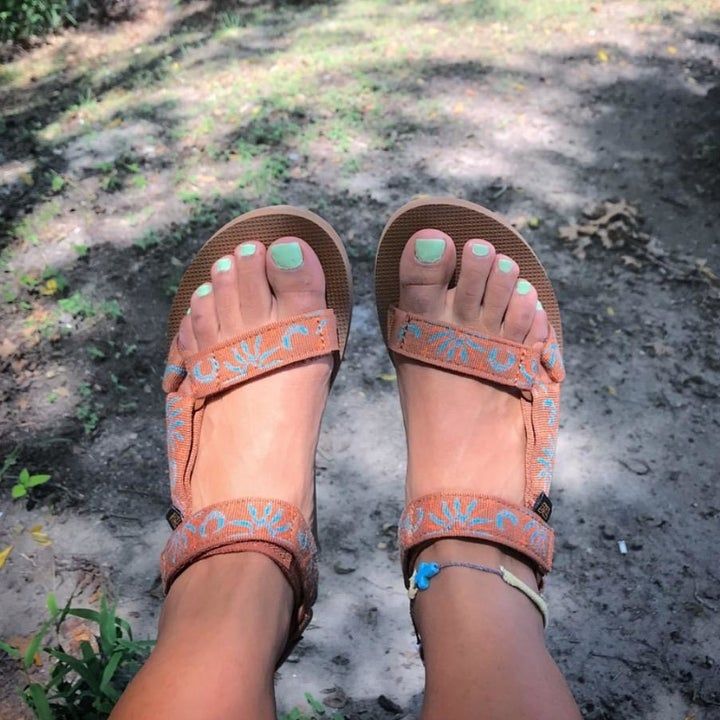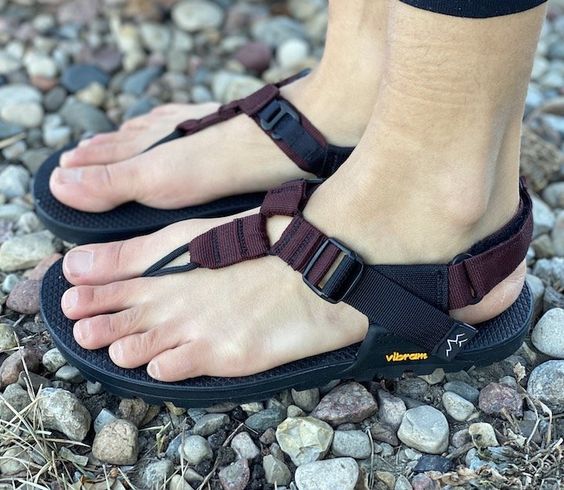Introduction to the controversy surrounding sandals and hiking
Are sandals good for hiking? This is a question that has sparked heated debates among outdoor enthusiasts. Some swear by the freedom and comfort of wearing sandals on the trails, while others argue that proper hiking boots are essential for safety, support and of course greater comfort. So, where does the truth lie in this controversy?
Whether you’re a sandal advocate or skeptic, this article will equip you with all the information you need to make an informed decision about your footwear choice. Let’s lace up our thoughts and hit the trail together.
Advantages of sandals for hiking.
When it comes to hiking, the right footwear can make all the difference. While traditional hiking boots are often touted as the go-to option, sandals have gained popularity among hikers in recent years. And it’s not very hard to see why.
Breathability
One of the major advantages of sandals for hiking is their breathability. Unlike closed shoes, sandals allow air to circulate around your feet, keeping them cool and preventing excessive sweating. This can be a game-changer on hot summer hikes or in humid climates.
Comfort
In addition to breathability, comfort is another key advantage of wearing sandals on a hike. Many hiking sandals are designed with cushioned soles and adjustable straps that provide a snug and customized fit. This means you can say goodbye to blisters and uncomfortable rubbing typically associated with ill-fitting shoes.
Weight reduction
Moreover, lightweight nature of sandals makes them an appealing choice for hikers looking to reduce weight on their feet during long treks. Say goodbye to bulky boots weighing you down! Sandals offer freedom of movement and flexibility while still providing adequate protection for your soles.
Water resistance
Another bonus is that most hiking sandals are water-resistant or quick-drying, making them ideal for water crossings or rainy weather conditions. You won’t have to worry about soggy socks or heavy wet shoes slowing you down.
While there are many advantages when it comes to wearing sandals for hiking, it’s important to note that they may not be suitable for every trail or terrain type. Lack of ankle support is one downside of wearing sandals – uneven surfaces may increase the risk of twisting an ankle if proper caution isn’t taken.
So ultimately, whether or not you should opt for sandals on your next hike depends on various factors such as personal preference and trail conditions. It’s always a good idea to consider alternative options like sport-specific hiking shoes before making your final decision.

Disadvantages of sandals for hiking.
When it comes to hiking, choosing the right footwear is crucial. While sandals may offer some advantages, they also come with their fair share of disadvantages.
Lack of ankle support and protection.
Hiking often involves uneven terrain and potential hazards like rocks, roots, and branches. Without proper ankle support from sturdy boots or shoes, you risk twisting or spraining your ankle during a hike. Sandals simply do not provide the same level of stability as closed-toe footwear.
Feet exposure
Additionally, sandals leave your feet exposed to external elements. Rocks, thorns, and insects can easily find their way into your sandals and cause discomfort or injury. In contrast, closed-toe shoes offer a protective barrier that prevents these irritants from coming into contact with your feet.
Limited cushioning
Another disadvantage of wearing sandals for hiking is the limited cushioning and shock absorption they provide. Hiking trails can be rugged and demanding on your feet. A lack of adequate cushioning can lead to foot fatigue or even pain in the long run.
Slippery on wet trails
Moreover, when hiking in wet conditions or crossing streams, waterlogged sandals can become slippery and increase the risk of falls or accidents. Closed-toe shoes are generally more suitable for such situations as they provide better traction on wet surfaces.
While there are certain types of sport sandals specifically designed for outdoor activities like hiking that offer improved support compared to regular fashion sandals, it’s important to consider these drawbacks before deciding if they’re suitable for your hiking needs.
Also, while sandals may be comfortable and breathable options for casual walks or beach outings during summer months but lacking essential features like ankle support and protection make them less than ideal choices for serious hikers tackling challenging terrains.
Types of sandals that are suitable for hiking.
When it comes to choosing the right sandals for hiking, there are a few different options that you can consider. Sport sandals and water shoes are two types of footwear that are popular among hikers for their versatility and durability.
Sports sandals
Sport sandals, also known as hiking sandals or adventure sandals, are designed specifically for outdoor activities like hiking. They typically feature sturdy soles with good traction to provide stability on various terrains. Many sport sandals also have adjustable straps that allow for a customizable fit, ensuring comfort during long hikes. These types of sandals often come with toe protection features such as rubber caps or reinforced materials to shield your feet from rocks and debris.
Water shoes
Water shoes, on the other hand, are great options if you’re planning on crossing streams or encountering wet conditions during your hike. Made from quick-drying materials like mesh or neoprene, water shoes offer excellent breathability while keeping your feet protected in damp environments.
Both sport sandals and water shoes excel in providing ventilation to keep your feet cool on hot days. This is particularly beneficial when hiking in warm climates or during summer months when closed-toe shoes may cause discomfort due to heat buildup.
It’s important to note that not all types of regular sandals will be suitable for hiking purposes. Flip-flops and flimsy beach-style flip-flop styles lack the necessary support and protection needed for more demanding trails.
Finding the perfect pair of hiking sandals depends on factors such as personal preference, trail difficulty level, weather conditions, and individual foot type. It’s always recommended trying them out before embarking on a challenging hike to ensure they meet both comfort and performance requirements!

Tips for choosing the right pair of sandals for hiking
When it comes to choosing the right pair of sandals for hiking, there are a few key factors to consider;
Comfort
First and foremost, you’ll want to prioritize comfort. Look for sandals with cushioning in the footbed and adjustable straps that can be tightened or loosened as needed.
Traction
Another important factor is traction. Hiking trails can be slippery, so opt for sandals with rubber outsoles that provide good grip on various surfaces. Additionally, consider the terrain you’ll be tackling – if you’re planning on hiking through rocky or uneven terrain, look for sandals with sturdy soles and toe protection.
Durability
Durability is also crucial when selecting hiking sandals. You want a pair that will withstand the rigors of outdoor adventures without falling apart after just a few uses. Look for materials such as nylon or synthetic leather that are known for their durability.
Proper fit
Proper fit is essential to prevent discomfort and blisters during your hike. Make sure to try on different sizes and styles to find the one that fits your feet best. Pay attention to any pressure points or areas where rubbing may occur.
Water resistance
Don’t forget about water resistance. If you anticipate encountering wet conditions or crossing streams during your hike, choose sandals made from quick-drying materials like neoprene or polyester webbing.
By considering these tips when choosing your hiking sandals, you can ensure a comfortable and enjoyable experience on the trails!
Proper foot care when wearing sandals on a hike
Proper foot care is essential when wearing sandals on a hike. While sandals provide breathability and comfort, they may not offer the same level of protection as hiking boots. Therefore, it is important to take extra precautions to ensure your feet remain safe and comfortable throughout your hike.
Moisturize your feet
Make sure to properly moisturize your feet before embarking on a hike. Dry skin can lead to discomfort and even blisters. Applying a moisturizer or foot cream will help keep your skin hydrated and reduce the chances of irritation.
Use blister prevention
Consider using blister prevention products such as moleskin or blister pads. These can be applied to areas prone to friction or rubbing in order to prevent blisters from forming.
Pay attention to discomfort
Additionally, pay attention to any hotspots or discomfort during your hike. If you start feeling any pain or irritation, take the time to address it immediately by adjusting your sandals or taking breaks if necessary.
Protect feet from debris
Furthermore, it’s important to protect your feet from debris and sharp objects that may be encountered on the trail. Wearing socks with sandals can provide an additional layer of protection against rocks, twigs, or other potential hazards.
Feet care after the hike
After completing your hike, take the time for proper foot care post-hike as well. Cleanse your feet thoroughly and apply lotion if needed.
By following these tips for proper foot care when wearing sandals on a hike, you can enjoy all the benefits that sandals offer without compromising on comfort and safety.

Alternative options to consider besides sandals for hiking
While sandals can be a great option for certain types of hikes, they may not be the best choice for everyone. If you’re looking for alternatives to sandals that provide more support and protection, here are a few options to consider:
1. Hiking boots: Hiking boots are specifically designed with rugged terrains in mind. They offer excellent ankle support and stability, which can be crucial when navigating uneven trails or carrying heavy backpacks. Additionally, hiking boots often have durable outsoles that provide superior traction on slippery surfaces.
2. Trail running shoes: For those who prefer a lighter and more flexible option, trail running shoes can be a good alternative to sandals. These shoes are designed to handle off-road terrain and typically have features like reinforced toe caps and sturdy soles for added protection.
3. Approach shoes: Popular among climbers, approach shoes blend the comfort of hiking footwear with the technical features of climbing shoes. They offer excellent grip on rocky surfaces while still providing enough flexibility for long-distance hikes.
4. Lightweight hiking sandals: If you still want the breathability and freedom that comes with wearing sandals but desire additional foot protection, lightweight hiking sandals could be an ideal compromise. These specialized outdoor footwear options often feature closed toes and thicker soles to shield your feet from rocks or debris.
Choosing the right footwear for your hike depends on personal preference as well as factors such as trail conditions, weather conditions, and the level of difficulty involved in your chosen route.
Before making any decision regarding what type of footwear is suitable for your hike, consider these factors carefully. Remember that comfort should always take priority in order to fully enjoy your outdoor experience.
So whether you opt for traditional hiking boots or decide that sport sandals are perfect
for your needs, make sure you select something appropriate based on where you’ll be trekking, how long you’ll be walking, and what kind of terrain you’ll encounter.


Leave a Reply